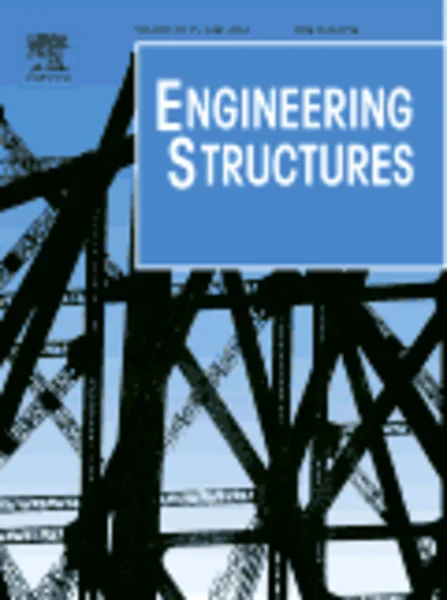-
emd-based random decrement technique for modal parameter identification of an existing railway bridge
جزئیات بیشتر مقاله- تاریخ ارائه: 1392/07/24
- تاریخ انتشار در تی پی بین: 1392/07/24
- تعداد بازدید: 1044
- تعداد پرسش و پاسخ ها: 0
- شماره تماس دبیرخانه رویداد: -
vibrational measurement data are often nonstationary and modal parameter identification based on these data is of practical value for structural health monitoring and condition assessment. the empirical mode decomposition (emd) is a most recent tool for analysis of nonstationary signals. an emd-based random decrement (rd) technique is presented to identify modal parameters from monitoring vibrational data. the nonstationary measurement data are first decomposed into a series of quasi-stationary intrinsic mode functions (imfs) by emd. the rd technique is then applied to the selected imfs to obtain the free-decay response. the modal frequencies and damping ratios are finally identified from the free-decay response by minimizing the error between the measured free-decay responses and the predicted responses from a parametric model. the present method is applied to extract the modal parameters of the nanjing yangtze river bridge from the measured responses. the identification result is compared to those from finite element analysis as well as from the experimental result identified with the peak-picking (pp) method. in addition, the modal frequencies of the bridge loaded with heavy trains are also identified and compared to the ‘empty’ bridge. the emd-based random decrement (rd) technique provides an effective and promising tool for modal parameter identification for large bridges and other structures.
مقالات جدیدترین رویدادها
-
استفاده از تحلیل اهمیت-عملکرد در ارائه الگوی مدیریت خلاقیت سازمانی و ارائه راهکار جهت بهبود
-
بررسی تاثیر ارزش وجوه نقد مازاد بر ساختار سرمایه شرکت های پذیرفته شده در بورس اوراق بهادار تهران
-
بررسی تأثیر سطح افشای ریسک بر قرارداد بدهی شرکت های پذیرفته شده در بورس اوراق بهادار تهران
-
بررسی تأثیر رتبه بندی اعتباری مبتنی بر مدل امتیاز بازار نوظهور بر نقد شوندگی سهام با تأکید بر خصوصی سازی شرکت ها
-
تأثیر آمیخته بازاریابی پوشاک ایرانی بر تصویر ذهنی مشتری پوشاک ایرانی (هاکوپیان)
-
بررسی رابطه هوش هیجانی با سبک های رهبری تحولی، تبادلی و آزاد گذار مورد مطالعه : بیمارستان های دولتی شهر اهواز
-
جایگاه و نقش فعالی تهای عملی (کارآموزی) در برنامه های درسی رشته های علوم انسانی
-
دل نیارامد به گفتار دروغ (بررسی صدق در مثنوی)
-
تحلیل چندفرکتالی نوسانات روندزدایی شده جریان رودخانه صوفی چای
-
مروری بر استفاده از لایه های تقویت کننده جهت کاهش اثر زلزله در محل های دفن زباله
مقالات جدیدترین ژورنال ها
-
مدیریت و بررسی افسردگی دانش آموزان دختر مقطع متوسطه دوم در دروان کرونا در شهرستان دزفول
-
مدیریت و بررسی خرد سیاسی در اندیشه ی فردوسی در ادب ایران
-
واکاوی و مدیریت توصیفی قلمدان(جاکلیدی)ضریح در موزه آستان قدس رضوی
-
بررسی تاثیر خلاقیت، دانش و انگیزه کارکنان بر پیشنهادات نوآورانه کارکنان ( مورد مطالعه: هتل های 3 و 4 ستاره استان کرمان)
-
بررسی تاثیر کیفیت سیستم های اطلاعاتی بر تصمیم گیری موفق در شرکتهای تولیدی استان اصفهان (مورد مطالعه: مدیران شرکتهای تولیدی استان اصفهان)
-
الگوی پیشنهادی نظام مند برای سیاست گذاری در آموزش و پرورش
-
مطالعه تطبیقی نظریه تقلید در باب هنر از دیدگاه فلسفه غرب و فلاسفه ایرانی اسلامی
-
بهداشت روح، ضرورت و اهمیت آن
-
بررسی رابطه بین عوامل شخصی و سازمانی افراد بر توانمند سازی آنها از دیدگاه روانشناسان
-
evaluation of load-bearing performance of existing cast steel node




سوال خود را در مورد این مقاله مطرح نمایید :